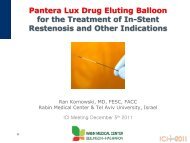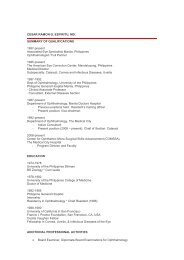Stroke During TAVI: An Unmet Clinical Need? - Paragon Conventions
Stroke During TAVI: An Unmet Clinical Need? - Paragon Conventions
Stroke During TAVI: An Unmet Clinical Need? - Paragon Conventions
Create successful ePaper yourself
Turn your PDF publications into a flip-book with our unique Google optimized e-Paper software.
<strong>Stroke</strong> <strong>During</strong> <strong>TAVI</strong>: <strong>An</strong><br />
<strong>Unmet</strong> <strong>Clinical</strong> <strong>Need</strong>?<br />
Stephen J.D. Brecker
Disclosures<br />
I have the following financial<br />
relationships to disclose:<br />
Proctor: Medtronic<br />
(Moderate)<br />
*Type of relation: Consultancy, employment, honoraria, other<br />
compensation<br />
*Level of remuneration: high (over $50,000 yearly), moderate (10-50,000),<br />
modest (under 10,000)
<strong>Stroke</strong> prevention in <strong>TAVI</strong>: <strong>An</strong> unmet<br />
clinical need?<br />
• The impact of stroke on <strong>TAVI</strong> outcomes<br />
• The mechanisms of stroke during <strong>TAVI</strong><br />
• <strong>Stroke</strong> prevention – what can we do?
Results of <strong>TAVI</strong> are improving<br />
• Source<br />
• Corevalve 18F<br />
• UK registry<br />
• Partner trial
<strong>Stroke</strong> is still a major source of co-<br />
morbidity<br />
• 2.9%–6.7% of patients undergoing<br />
transfemoral <strong>TAVI</strong> (with both the Edwards<br />
SAPIEN or CoreValve device) and 1.8%–5% of<br />
patients undergoing transapical<br />
<strong>TAVI</strong> (Edwards SAPIEN).
<strong>Stroke</strong> post <strong>TAVI</strong> – The registry data
The Source Registry
Source 30 day outcomes<br />
No major difference between femoral and apical access
New Perspectives on <strong>Stroke</strong><br />
<strong>During</strong> <strong>TAVI</strong><br />
Ghanem et al., J Am Coll Cardiol 2010;55:1427–32.
Background<br />
• <strong>TAVI</strong>-related stroke is an important complication (1-<br />
10%). The risk of silent cerebral embolism is not<br />
elucidated yet.<br />
• Diffusion-weighted MRI allows detection and<br />
localization of acute - apparent and silent - ischemic<br />
cerebral lesions.<br />
• DW-MRI studies are of potential interest for preinterventional<br />
risk stratification, peri-interventional<br />
anticoagulation management...<br />
Grube et al., JACC (2007), Webb et al., Circulation (2008), Zajarias et al., JACC (2009)
Study design<br />
Evaluation<br />
<strong>Clinical</strong> and neurological assessment (NIHSS)<br />
Lab - Tests (incl. Lactate, NSE)<br />
MRI<br />
<strong>TAVI</strong><br />
<strong>Clinical</strong> and neurological assessment (NIHSS)<br />
Lab - Tests (incl. Lactate, NSE)<br />
MRI<br />
<strong>Clinical</strong> and neurological assessment (NIHSS)<br />
Lab - Tests (incl. Lactate, NSE)<br />
MRI<br />
E1<br />
E2<br />
E3
E1<br />
DW-MRI•<br />
NIHSS (n=30) •<br />
NSE•<br />
<strong>TAVI</strong><br />
E2<br />
DW-MRI (n=22) •<br />
NIHSS•<br />
NSE•<br />
E3<br />
DW-MRI (n=22) •<br />
NIHSS•<br />
NSE•<br />
Protocol<br />
Death (n=2)<br />
New onset of claustrophobia (n=1)<br />
Hemodynamic instability (n=1)<br />
PM-Therapy (n=4)<br />
•<br />
•<br />
•<br />
•
DW - MRI
Lesion localisation and size<br />
Vascular<br />
territories<br />
<strong>An</strong>terior<br />
cerebral artery<br />
Middle<br />
cerebral artery<br />
Posterior<br />
cerebral artery<br />
Vertebrobasilary<br />
arteries<br />
DW-MRI lesion<br />
volume range [cm³]<br />
0.1 – 59.2<br />
0.1 – 4.5<br />
0.1 – 8.6<br />
0.1 – 1.6
NIH-<strong>Stroke</strong> Score<br />
20<br />
18<br />
16<br />
4<br />
2<br />
0<br />
NIH <strong>Stroke</strong> Scale<br />
n=30<br />
n=1<br />
n=1<br />
n=1<br />
n=27<br />
E1 E2 E3
Results<br />
• DW-MRI, but not NSE, detects cerebral embolic<br />
lesions.<br />
• Silent cerebral embolism is frequent following<br />
<strong>TAVI</strong> (73%)<br />
• The incidence of apparent cerebral embolism is<br />
low (3.6%).
What about Transfemoral vs<br />
Transapical?
Study Design
DW-MRI Results Post <strong>TAVI</strong>
Larger Number of MRI Lesions in<br />
TA group
Neurological and Cognitive Test<br />
Results
Conclusions<br />
• <strong>TAVI</strong> was associated with a high rate ( 68% ) of<br />
new silent cerebral ischaemic lesions as<br />
evaluated by DW-MRI, with no differences<br />
between the TF ( 66%) and the TA (71%)<br />
approaches<br />
• The occurrence of new silent cerebral<br />
ischaemic lesions was not associated with an<br />
impairment of neurological or cognitive<br />
functions
Significance of MRI lesions?<br />
• No long term clinical significance or just<br />
NIHSS/Cognitive function testing not sensitive<br />
enough to pick them up?
What are the mechanisms of<br />
• Crossing the aortic valve<br />
• Arch atheroma<br />
• Balloon valvuloplasty<br />
• Pigtail catheter thrombosis<br />
• Valve deployment<br />
<strong>Stroke</strong> during <strong>TAVI</strong><br />
• Post dilatation balloon/valvuloplasty
Mechanisms of <strong>Stroke</strong> during <strong>TAVI</strong><br />
– Crossing the aortic valve
Mechanisms of <strong>Stroke</strong> during <strong>TAVI</strong> –<br />
Crossing the aortic valve<br />
• Silent and apparent cerebral embolism after<br />
retrograde catheterisation of the aortic valve<br />
in valvular stenosis : a prospective,randomised<br />
study Omran H Lancet 2003 12;361(9365):1241-6<br />
• 22% (22/101) patients had focal diffusion<br />
imaging abnormalities on MRI<br />
• 3% clinically apparent neurological defects<br />
• All 51 patients with AS who did not have the<br />
valve crossed had no abnormalities on MRI
Mechanisms of <strong>Stroke</strong> during <strong>TAVI</strong> –<br />
Arch Atheroma
Aortic Atheroma <strong>An</strong>d AS
Mechanisms of <strong>Stroke</strong> during <strong>TAVI</strong> –<br />
Balloon valvuloplasty
Mechanisms of <strong>Stroke</strong> during <strong>TAVI</strong> –<br />
Balloon valvuloplasty<br />
• <strong>Stroke</strong> rates in literature range from 1-5%<br />
Cribier A,Percutaneous transluminal valvuloplasty of acquired aortic stenosis in elderly patients:<br />
an alternative to valve replacement? Lancet. 1986;1:63-67.<br />
Safian RD, Balloon aortic valvuloplasty in 170 consecutive patients. N Engl J Med. 1988;319:125-<br />
130.<br />
Otto CM, Mickel MC, Kennedy JW, et al. Three year outcome after balloon aortic valvuloplasty:<br />
insights into prognosis of valvular aortic stenosis. Circulation. 1994;89:642-650.<br />
Eltchaninoff H, Cribier A, Tron C, et al. Balloon aortic valvuloplasty in elderly patients at high risk<br />
for surgery or inoperable. Immediate and mid-term results. Eur Heart J. 1995;16:1079-1084.<br />
Pedersen WR, Klaassen PJ, Boisjolie CR, et al. Feasibility of transcatheter intervention for severe<br />
aortic stenosis in patients > 90 years of age: aortic valvuloplasty revisited. Cathet Cardiovasc<br />
Interv. 2007;70:149-154.
Mechanisms of <strong>Stroke</strong> during <strong>TAVI</strong> –<br />
Catheter Thrombosis<br />
• Long periods of valve repositioning in difficult<br />
cases<br />
• Pigtail catheter thrombosis<br />
• Trade off in anticoagulation between stroke<br />
risk and vascular complications from closure<br />
device failure<br />
• Ideal ACT for procedure?
Mechanisms of <strong>Stroke</strong> during <strong>TAVI</strong> –<br />
Valve Deployment
What can we do stop the shower?
The Future of <strong>Stroke</strong> Prevention in <strong>TAVI</strong>?<br />
Umbrella/deflector devices<br />
3 currently available devices:<br />
The Claret Dual Filter device•<br />
The Embrella device•<br />
The Aortic Embolic Protection Device (AEPD )<br />
•
Brachiocephalic trunk<br />
Cerebral Filter Protection<br />
Claret Device<br />
Left<br />
Common<br />
carotid
Claret Dual Filter
Embolic Material
Embolic Material
Embrella Embolic Deflector<br />
• Porous membrane<br />
designed to deflect<br />
embolic debris<br />
• Nitinol frame and shaft<br />
• Polyurethane Porous<br />
membrane<br />
• Heparin coating<br />
• 3 radiopaque markers<br />
• Suture, Monofilament<br />
Nylon
Concept Embrella<br />
Separate access site from main •<br />
procedure, Radial or brachial<br />
artery<br />
Fits through a 6F sheath•<br />
Minimal orientation•<br />
Ease of use, no new techniques•<br />
Low profile•<br />
One size fits all•<br />
Deflect debris•
Embrella Case Example
Embrella Case Example
Embrella Case Example
Embrella Case Example – No<br />
difficulty crossing device
Embrella <strong>Clinical</strong> Experience
11 fold decrease in MRI lesion<br />
volume
Average number of Lesions/Subject
55% decrease in TCD Hits
Aortic Embolic Protection Device<br />
( AEPD)<br />
SMT Research and Development, Ltd.,<br />
Herzliya, Israel
What about post <strong>TAVI</strong>?
Post <strong>TAVI</strong> <strong>An</strong>tiplatelet Therapy<br />
• No randomised trials as yet.<br />
• Initial experiences with <strong>TAVI</strong> and no DAP –<br />
thrombus noted on the valves.<br />
• Elderly patients on DAP have a significant<br />
incidence of bleeding<br />
• <strong>Need</strong>s evaluation
Thank you for your attention






